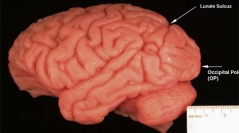

 Comptes Rendus Palevol
3 (4) - Pages 287-293
Comptes Rendus Palevol
3 (4) - Pages 287-293Since Dart’s analysis of the Taung skull in1925 in Nature, there has been controversy surrounding the presence of a clearly defined lunate sulcus (LS) in the australopithecines, marking the anterior extent of primary visual cortex (PVC). An anterior position signifies that the LS is in an ape-like position, such as found in Pan troglodytes. A posterior position is a more human-like characteristic (autapomorphy). If the latter occurred in Australopithecus, then the cerebral cortex underwent some neurological reorganization prior to brain enlargement, thus occurring earlier than the emergence of the genus Homo. The endocast of the Stw 505 specimen from Sterkfontein, South Africa, shows an unmistakably posterior placement of the LS. The early hominid brain was reorganized at least by the time of Australopithecus africanus, thus vindicating Dart’s early assessment.
Australopithecus africanus, sulcus lunatus, cerebral evolution